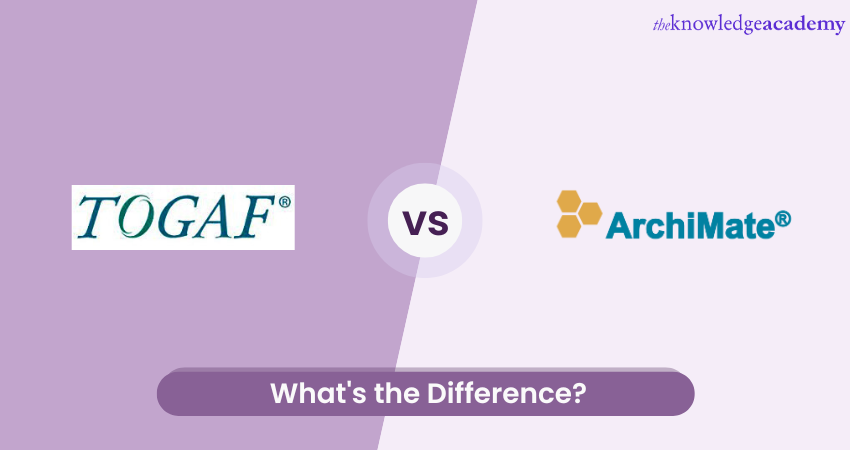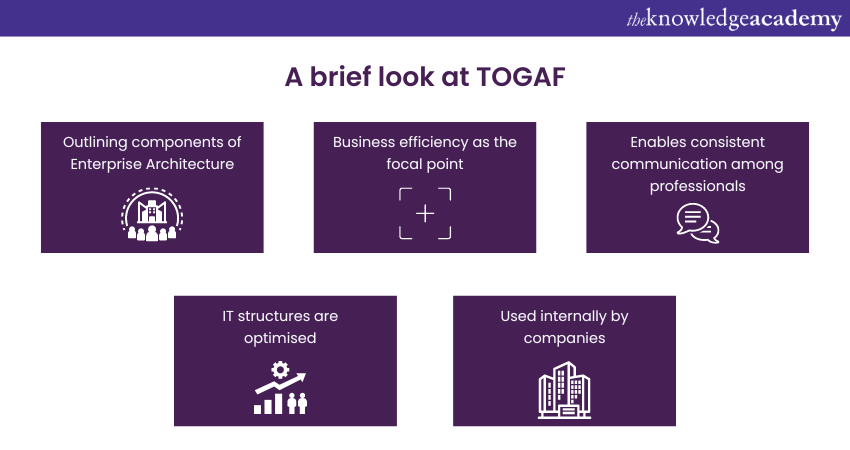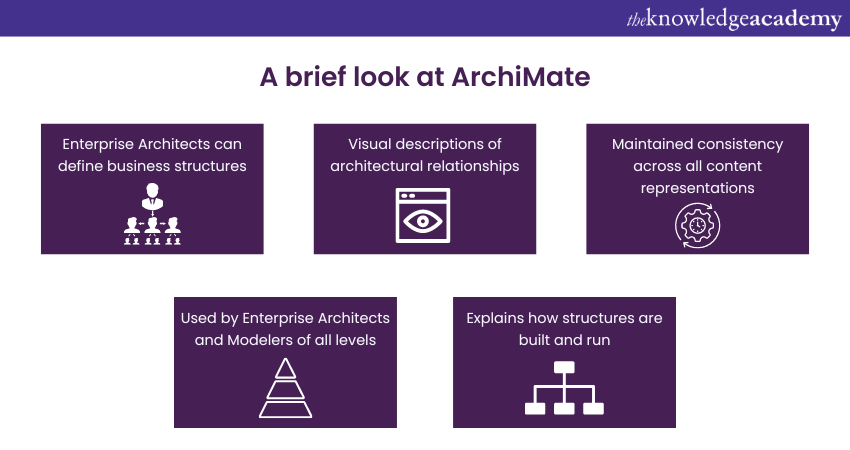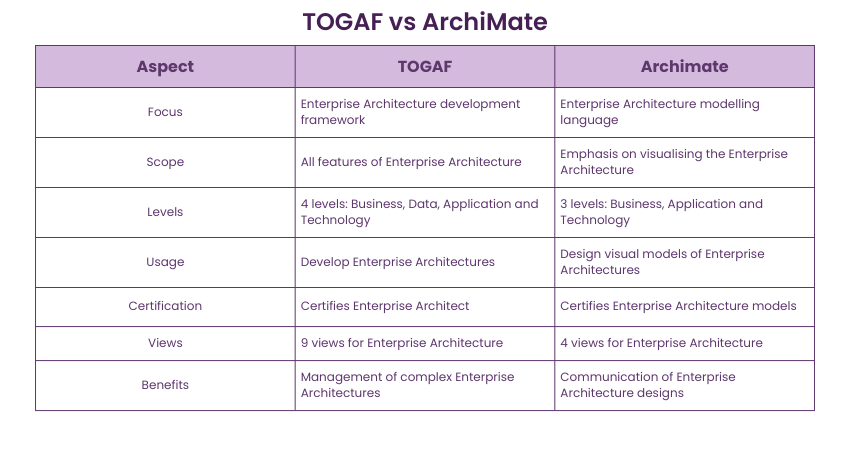We may not have the course you’re looking for. If you enquire or give us a call on +1 7204454674 and speak to our training experts, we may still be able to help with your training requirements.
We ensure quality, budget-alignment, and timely delivery by our expert instructors.

TOGAF vs ArchiMate is an important comparison for Enterprise Architects (EAs) to understand so that they can assist businesses in achieving their objectives with the latest technology standards. Both frameworks aid businesses in comprehending the emerging needs of their customers. They are enterprise architecture methodologies that guide EAs in designing and analysing IT architectures.
According to TheOpenGroup.org, roughly 120,000 people worldwide have earned the TOGAF certification. Another study conducted by The Data Warehousing Institute revealed that approximately 44% of IT organizations focus on Enterprise Architecture (EA). This blog will discuss the two distinct frameworks. ArchiMate is a general-purpose modeling language, while TOGAF is an Enterprise Architecture Framework.
Table of Contents
1) A brief look at TOGAF
2) A brief look at ArchiMate
3) A comparison: TOGAF vs ArchiMate
4) Choosing between ArchiMate and TOGAF
5) Conclusion
A brief look at TOGAF

TOGAF is used by business organisations to define the components of their enterprise architectures and to create and manage these architecture components. The primary goal of using the TOGAF framework is to improve business efficiency. TOGAF is considered to be one of the most reliable and noteworthy Enterprise Architecture standards, which facilitates consistent communication among Enterprise professionals.
The main focus of Enterprise Architecture is to analyse and understand an organization’s IT structure. The Enterprise Architect outlines the relationships and processes maintained in a business to optimise efficiency and direction for IT. TOGAF is best suited for businesses that aim to optimise their IT workflows and infrastructure. Experienced Enterprise Architects can create architectures that take into account the vision of the business future.
The TOGAF framework was developed by The Open Group in 1995, and by 2016, approximately 60% of Fortune 500 organisations were utilizing this framework. Organisations can ideally use TOGAF for internal purposes rather than commercial. The Open Group provides eight certified tools for TOGAF and offers 71 courses across 70 organisations.
A brief look at ArchiMate

ArchiMate is a graphical modeling language used to establish and define business architectures, which helps enterprise organisations visualise the various components of corporate architectures. The language specifies graphical notations and conventions in one collection, with resources like the ArchiMate Cookbook offering practical guidance for effective usage.
The modeling tool is backed by many tool providers and consulting organisations, and it provides organisations with tools to support Enterprise Architects in their descriptions, analysis, and visual representations of the relationships between the many architectural domains.
ArchiMate Diagram provides organizations with a consistent and straightforward approach for representing content in these domains and clarifying interactions across architectural areas. The functionality of ArchiMate is quite similar to how traditional sketches of structural architectures illustrate the various components of the structure's construction and usage.
The tool is intended for use by enterprise architects and modelers of all levels, offering low-cost entry solutions for users taking their first steps in the language. It is also beneficial for those who require an open-source modeling tool for their organisation.
Enterprise architects can use ArchiMate to explain how the structure of things is built and run, all in the same language. Examples of the things that can be built using ArchiMate include:
1) Organisational Designs
2) IT Programs
3) Information Flow
4) Technical Foundation
Explore the comprehensive TOGAF terminology guide to master key concepts, definitions, and frameworks today!
Viewpoints
ArchiMate includes an essential concept known as "Viewpoints." Viewpoints consist of a set of ArchiMate elements that allow Architect Designers to model specific aspects of any enterprise architecture.
For example, ArchiMate 3 is a specification that provides architects with 23 example viewpoints to adhere to. These viewpoints serve as starting points for modelling activities, and each one addresses the concerns of stakeholders.
These viewpoints are segregated into four groups:
1) Basic Viewpoints: These viewpoints can conceptually utilise the three layers of Technology, Business, and Application.
2) Motivation Viewpoints: These viewpoints are used to model an architecture's motivational features.
3) Strategy Viewpoints: These viewpoints can describe an enterprise's strategic aspect through high-level directives and the overall structure.
4) Migration and Implementation Viewpoints: Architectural change can be modeled from the relationships between the objects and programs.
5) Triple Framework Comparison: Understand the unique aspects and benefits of ITIL vs COBIT vs TOGAF in our extensive comparison guide.
Discover Key Differences: Explore our comprehensive comparison of TOGAF vs ITIL to understand which framework suits your needs best.
Framework Showdown: Delve into the detailed analysis of TOGAF vs ArchiMate and learn how they align with your enterprise architecture goals.
Security vs Architecture: Read our in-depth guide on TOGAF vs SABSA to see how they stack up in addressing security architecture.
Framework Comparison: Compare the strengths and applications of TOGAF vs Zachman to determine the best fit for your organization.
Enterprise architects must ensure to carry out modifications on the example viewpoints or define their own viewpoints. In the context of ITIL vs. COBIT vs. TOGAF, self-definition can be utilised to address specific concerns of stakeholders.

A comparison: TOGAF vs ArchiMate
Both the TOGAF framework and the ArchiMate modeling language tool are standards for enterprise architecture designed by The Open Group. Here are the ways how they perform in very distinct and different ways:

Enterprise architectures consist of key components, such as analysing and understanding an organisation's IT structure. Enterprise architects identify the connections and processes within the organisation to optimise IT workflows and direction.
As an organisation grows more complex, the clarity and viewpoint of its corporate architecture become increasingly important and difficult to achieve. To address these challenges, business organisations use enterprise architecture frameworks designed with industrial best practices, equipment, and recommendations from experienced enterprise architects.
Qualified architects possess years of experience in the real world, which enables them to design comprehensive architectures that address the various facets of a typical organisation. These architectures are helpful in taking an organisation forward.
The popularity of an organisation's architecture is determined by the competition between different enterprise frameworks. TOGAF offers organisations a flexible and adaptable approach to Enterprise Architecture (ADM), while ArchiMate, a modelling language for enterprise architectures, communicates the principles of Enterprise Architecture to a wide range of audiences, independent of their educational background or experience.
ArchiMate was developed alongside TOGAF and other frameworks by The Open Group. It is generally recommended to lean towards one framework, but it is still beneficial for business architect aspirants to learn both frameworks.
Understand stakeholder identities and business communication, by signing up for the TOGAF® Foundation And Practitioner Training course now!
Choosing between ArchiMate and TOGAF
TOGAF is best suited for business organizations that look to optimise their IT infrastructures, whether for regular organisational operations or for supporting significant changes in IT processes.
TOGAF enterprise architectures typically focus on designing architectures for both the current and future states of any business, making it an essential part of a Business Architect role where professionals work to align IT strategies with organizational goals. This architectural design, considering both states, significantly helps the organisation in its transition from a current state to a new state.
TOGAF describes all the components included in enterprise architecture, including the Business, Data, Applications, and Technology architecture. All these components, when combined, work in tandem to create the overall image of an organisation, although practitioners of the TOGAF framework can also choose which factors are necessary to highlight.
The Open Group offers distinct certifications, such as the TOGAF BA, to audiences or customers with a more specific focus or requirement. Designed to be a vendor-neutral framework, TOGAF is customisable to suit the requirements of any business organization or company. The framework is customisable because the ADM itself allows for the steps involved to be rearranged to a large extent. Companies can also run more smoothly by reusing the artifacts generated by the projects in TOGAF.
Practitioners of the TOGAF framework generally find it easy to cooperate on projects due to the standard nomenclature of TOGAF. The ease of cooperation not only applies to any project but also between businesses. The requirement of TOGAF for a company depends on its level of efficiency, governance, and clarity. TOGAF also aids companies in gaining a comprehensive understanding of how IT operates in their business. This understanding includes what IT does, who is involved in the process, and where the IT process can be enhanced.
Furthermore, the transparency facilitated by the TOGAF framework allows the company's stakeholders to arrive at the best judgments for their strategies. The framework can be an ideal choice for a company if they intend to step up their IT work processes or to implement important business goals for their digital transformation.
If a company is not utilising corporate architecture, it will not require the use of ArchiMate. ArchiMate is a tool designed to assist with enterprise architecture, but it does not help aspirants and applicants in developing architectures from the ground up.
Now, ArchiMate and TOGAF are both architectural standards designed for business organisations by The Open Group. However, it is essential to remember that both frameworks have been made for very different purposes. For instance, an EA modelling language does not exist in TOGAF. It rather offers architects the necessary resources and best practices they can utilise. TOGAF is the de-facto standard for organisations all over the world and has been bestowed with the reputation of the most popular and desired architectural framework for businesses.
Applicants should remember that the ArchiMate modelling tool does not provide them with plans for their digital transformation or any artifacts or processes for developing EAs. ArchiMate rather conveys the features to the company's stakeholders, IT workers, and other target audiences in an understandable fashion.
Organisations can come up with a completely optimised enterprise architectural practice by merging ArchiMate with TOGAF. ArchiMate also helps easily convey modifications in the architecture.
Explore our comprehensive guide on TOGAF ADM phases explained to gain insights into every stage of the Architecture Development Method. Master your architecture strategy today!
Conclusion
Organisations can optimise their EA practice by combining TOGAF with ArchiMate. The TOGAF vs ArchiMate comparison highlights how the former’s adaptable approach and the latter’s easy conveyance of architectural modifications help organisations significantly.
A company can build its own architectures best suited to its needs. Creating an ArchiMate Cheat Sheet can be a valuable resource for organizations adopting the ArchiMate framework, summarizing key concepts, notations, and best practices for efficient and effective implementation. In addition to understanding frameworks like ArchiMate, many professionals are curious about compensation in the field, such as Business Architect Salary, which can vary depending on the organization and experience level. Although the combination of the two makes an optimal fit, The Open Group recommends that companies incline towards one framework.
Learn business modelling, capabilities and create business architectures, by signing up for the TOGAF BA Foundation Training course now!
Upcoming Business Improvement Resources Batches & Dates
Date
 TOGAF® Foundation and Practitioner - Foundation Training
TOGAF® Foundation and Practitioner - Foundation Training
Mon 21st Apr 2025
Mon 26th May 2025
Mon 23rd Jun 2025
Mon 14th Jul 2025
Mon 18th Aug 2025
Mon 22nd Sep 2025
Mon 6th Oct 2025
Mon 3rd Nov 2025
Mon 1st Dec 2025






 Top Rated Course
Top Rated Course


 If you wish to make any changes to your course, please
If you wish to make any changes to your course, please


